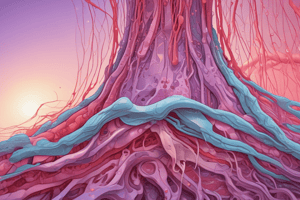Podcast
Questions and Answers
What is the primary function of epithelial tissue in the body?
What is the primary function of epithelial tissue in the body?
What type of epithelial tissue is found in the skin?
What type of epithelial tissue is found in the skin?
What is the main function of goblet cells?
What is the main function of goblet cells?
What is the characteristic of simple epithelial tissue?
What is the characteristic of simple epithelial tissue?
Signup and view all the answers
What type of epithelial tissue is found in the lungs?
What type of epithelial tissue is found in the lungs?
Signup and view all the answers
What is the function of microvilli cells?
What is the function of microvilli cells?
Signup and view all the answers
Study Notes
Characteristics of Epithelial Tissue
- Covers the body's internal and external surfaces
- Lines cavities, glands, and organs
- Forms the lining of blood vessels and lungs
- Composed of tightly packed cells with little intercellular substance
Functions of Epithelial Tissue
- Protection: prevents water loss, regulates what enters/leaves the body
- Absorption: nutrients, gases, and ions
- Secretion: hormones, enzymes, and other substances
- Excretion: waste removal
- Sensation: detects light, sound, touch, taste, and smell
Types of Epithelial Tissue
-
Simple Epithelium
- Single layer of cells
- Lines blood vessels, lungs, and kidney tubules
-
Stratified Epithelium
- Multiple layers of cells
- Found in skin, mouth, and vagina
-
Pseudostratified Epithelium
- Single layer of cells, but appears stratified due to varying cell heights
- Lines respiratory tract and some glands
-
Cuboidal Epithelium
- Cube-shaped cells
- Found in kidneys, thyroid, and adrenal glands
-
Columnar Epithelium
- Elongated cells
- Lines digestive tract and some glands
-
Squamous Epithelium
- Flat cells
- Found in skin, lungs, and blood vessels
Specialized Epithelial Cells
- Goblet cells: produce mucus
- Cilia cells: have hair-like structures for movement
- Microvilli cells: have small projections for absorption
- Stereocilia cells: have long, non-motile projections for sensory function
Epithelial Tissue Characteristics
- Epithelial tissue covers the body's internal and external surfaces, including cavities, glands, and organs.
- It forms the lining of blood vessels and lungs.
- The tissue is composed of tightly packed cells with little intercellular substance.
Epithelial Tissue Functions
- Provides protection by preventing water loss and regulating what enters and leaves the body.
- Facilitates absorption of nutrients, gases, and ions.
- Enables secretion of hormones, enzymes, and other substances.
- Performs excretion by removing waste products.
- Detects light, sound, touch, taste, and smell through sensation.
Types of Epithelial Tissue
Simple Epithelium
- Consists of a single layer of cells.
- Lines blood vessels, lungs, and kidney tubules.
Stratified Epithelium
- Composed of multiple layers of cells.
- Found in skin, mouth, and vagina.
Pseudostratified Epithelium
- Appears stratified due to varying cell heights, but is a single layer of cells.
- Lines the respiratory tract and some glands.
Cuboidal Epithelium
- Cells are cube-shaped.
- Found in kidneys, thyroid, and adrenal glands.
Columnar Epithelium
- Cells are elongated.
- Lines the digestive tract and some glands.
Squamous Epithelium
- Cells are flat.
- Found in skin, lungs, and blood vessels.
Specialized Epithelial Cells
- Goblet cells: produce mucus.
- Cilia cells: have hair-like structures for movement.
- Microvilli cells: have small projections for absorption.
- Stereocilia cells: have long, non-motile projections for sensory function.
Studying That Suits You
Use AI to generate personalized quizzes and flashcards to suit your learning preferences.
Description
This quiz covers the characteristics and functions of epithelial tissue, including its role in covering body surfaces, lining cavities, and performing various physiological functions.




